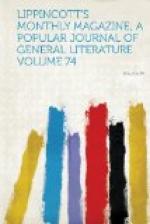“And,” continued Schuster Alois, “that is only one tale amongst the hundreds which could be related concerning these crucifixes. Ah, there is many an old, bleached, weather-beaten crucifix on crag or highway-side from which the anguished face of the Saviour has both smitten and healed the sinner. Crucifixes cut deeper into most Tyrolese hearts than shrines, some way.”
“Strange,” we replied, “for these old shrines are not only quaint, but often beautiful, as, for instance, the one on the roadside turning into town.”
“Ah, I am glad you like it,” said Alois, “for there are those who would wish it pulled down and a lofty wooden cross, as a landmark, placed there instead. The Capuchins in the adjoining monastery are opposed to it, however, and no wonder. Have you ever remarked,” he continued, becoming quite aglow, “that although it is greatly injured and many of the figures lost, still there are others who look at you so calmly and seriously with their marred, dilapidated countenances that you feel a peace steal into your heart? And whoever the painter was, he must have loved his work, for Saint Gregory could never have been more dignified in real life than he looks in the shrine.”
“Are you a painter?” we asked, almost without knowing what we were saying, for it was hardly probable.
“Oh, I only touch colors now and then, when there’s a purpose in it or I can serve the Church,” he returned. He became embarrassed, and explained that it was time to return to his work.
We afterward learnt from Moidel that Alois bore in the neighborhood far and wide the reputation of an artist, although he did not consider himself such, seeing he could not paint saints and angels. It was, however, a great source of pleasure to him to paint mottoes and devices and to arrange floral decorations, especially when they could serve as a surprise for some private name-day or church festival.




